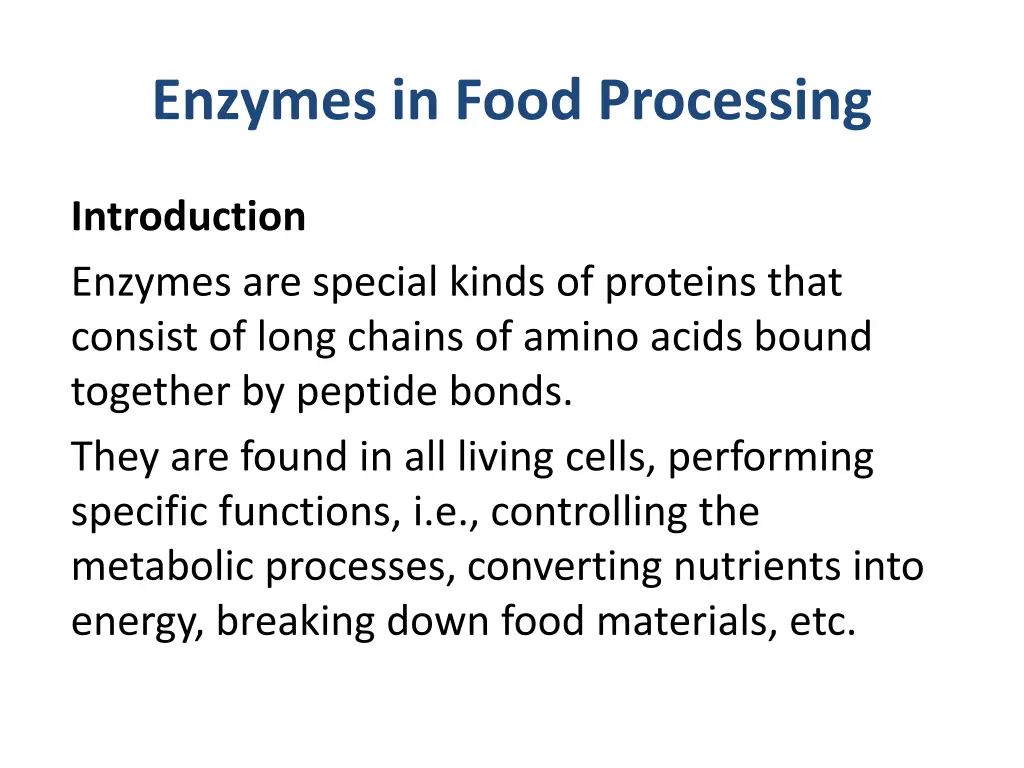
Understanding Enzymes in Food Processing
Explore the role of enzymes in food processing, their characteristics, sources, and applications in the food industry. Learn why enzymes from microbes are preferred and how they enhance productivity and quality in food production.
Download Presentation

Please find below an Image/Link to download the presentation.
The content on the website is provided AS IS for your information and personal use only. It may not be sold, licensed, or shared on other websites without obtaining consent from the author. If you encounter any issues during the download, it is possible that the publisher has removed the file from their server.
You are allowed to download the files provided on this website for personal or commercial use, subject to the condition that they are used lawfully. All files are the property of their respective owners.
The content on the website is provided AS IS for your information and personal use only. It may not be sold, licensed, or shared on other websites without obtaining consent from the author.
E N D
Presentation Transcript
Enzymes in Food Processing Introduction Enzymes are special kinds of proteins that consist of long chains of amino acids bound together by peptide bonds. They are found in all living cells, performing specific functions, i.e., controlling the metabolic processes, converting nutrients into energy, breaking down food materials, etc.
Enzyme Characteristics There are three main characteristics of enzymes. High activity, Enzymes can increase the rate of a reaction millions of times by lowering the activation energy of the reaction like conventional chemical catalysts. Selectivity, The catalytic active site of an enzyme fits only to a small (specific) number of substrates for the conversion to products. Controllability, The reactions by enzymes can be controlled by the amount of substrate and by other factors (temperature, pH, etc.).
Introduction Enzymes are known as protein catalysts that, like all other catalysts, speed up the rate of a chemical reaction without being used up in the process. Environmental conditions (temperature, pressure, and acidity) play an important role in enzyme functionality.
Source of Enzymes Commercial sources of enzymes are any living organism, i.e., animals, plants, and microbes. These naturally occurring enzyme sources are quite readily available for the commercial productivity of sufficient quantities for food applications. The major industrial enzymes come from microorganisms and the remainder, from animals (8%) and plants (4%).
Source of Enzymes Enzymes from microbes are preferred than from animals and plants because. (1) they are cheaper to produce. (2) they are more predictable and controllable. (3) they are reliable supplies of raw materials of constant composition; and (4) plant and animal tissues contain more harmful materials (phenolics, inhibitors, etc.).
Enzyme Applications in the Food Industry Industrial enzymes are used in the production of diverse products such as cheese, sausages, baked goods, juices, and egg white substitutes. They are used to reduce viscosity, improve extractions, enhance separations, develop functionality, and create flavor.
Enzyme Applications The enzymes are produced from microorganisms with a variety of application in the food industries (Table 1). Enzymes can also be very important tools for protein modification since they provide fast reaction rates, mild conditions and high specificity which lead to economic, health, and safety benefits.
Table: 1. Marketed Enzymes and Uses in Food Production
Enzyme Applications Enzymes could also be used to modify insoluble biopolymers and this is very important to the food industry. Examples include pectinase use in fruit juice, production of yeast hydrolysates, solids waste treatment, and other.
Enzyme Applications Enzymes have also been used to increase oil and protein release. Reports on sunflower, coconut, olive, and cottonseed have shown a high oil extraction yield using enzymes in the aqueous medium.






















